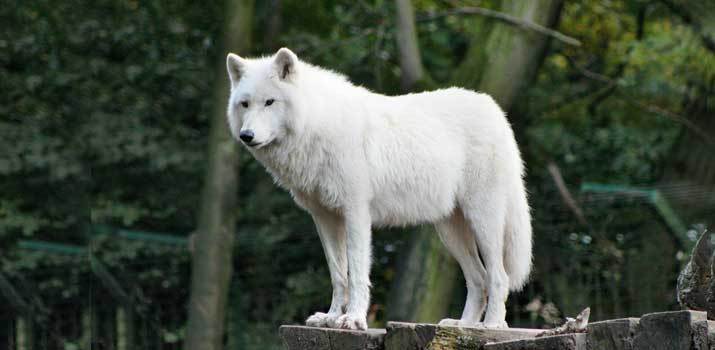
Wolves are majestic creatures that take on a somewhat mystical role in numerous cultures around the world. Their mysterious behavior, pack mentality, and sheer beauty makes them a beloved animal for many.
While it's common for young kids and young-at-heart adults to dream about owning a pet wolf one day, it's simply not an option. Wolves are wild creatures that just aren't suited for domestic life. They're fiercely predatory, very cunning, and independent.
These animals need to roam the planet in the wild, not be cooped up in suburbia.
While you can't own a wolf for yourself, you can get the next best thing. There are a number of domesticated dogs that share a lot of the same physical traits as wild wolves.
These breeds have the same dignified beauty as their wild counterparts but have much more manageable personalities that mesh well with modern human life.
Understanding Canine and Wolf Genetics
Contrary to popular belief, dogs are not direct descendants of gray wolves. This idea was once accepted as fact. However, recent genetic studies have shown that wolves and dogs actually share a common ancestor.
Essentially, this means that modern dogs evolved from the early ancestors of the wolves we see today. They're more like cousins rather than direct relatives.
Even still, domesticated dogs still share a lot of the same DNA as wolves. Yes, even those tiny lap dogs have similar genetic codes to wild wolves. However, the traits that come from that shared DNA are not active.
Selective Breeding
Selective breeding techniques can be used to try and make those traits active. While activating that DNA doesn't make the dog into a wolf, it does lead to a lot of shared physical characteristics.
Because of this comparable genetic makeup, dogs can also be bred with wolves, resulting in a wolfdog.
Wolfdogs
Wolfdogs are the closest thing you're going to get to owning a wolf. The breeding process results in a canine that not only looks like a wolf but also has many of the same personality traits. This has its advantages and disadvantages.
When selective breeding is done, you're mixing wild genes with domesticated ones. Wolfdogs tend to be very predatory and have a knack for causing some destruction in the backyard.
Thanks to their domestic side, these personality traits are not nearly as bad as actual wolves, but they are something to be aware of. Temperament can be a tricky thing to deal with.
In fact, many jurisdictions have strict rules regarding wolfdogs because of their unpredictable behavior.
Wolf-Like Dogs
It can be easy to mix up wolfdogs and wolf-like dogs. Wolfdogs are born out of selective breeding. Wolf-like dogs, on the other hand, are an established breed that just so happens to look like a wolf.
These breeds do carry some behavioral quirks, such as pack mentality and prey drive. However, those traits are all heavily recorded, understood, and predictable.
9 Dogs That Look Like Wolves
So you want a dog that looks like a wild wolf. Well, you have plenty of great options. The following breeds have a striking visual appearance and unique personalities. These dogs aren't for everyone. Most of them require strict training regimes to truly thrive at home.
However, if you have the patience and know-how, they'll make an excellent addition to your family.
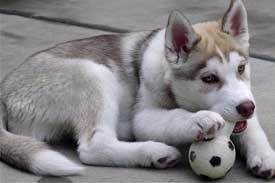
#1. Siberian Husky
Siberian Huskies are, perhaps, the most popular wolf-like dog breed around. These dogs are very beautiful and highly sought-after due to their piercing blue eyes.
Like wolves, Huskies have a triangular head and perky ears. Another similarity that Huskies have with wolves is their facial markings. Many dogs are multi-colored and have lines of color surrounding their eyes.
The biggest difference these dogs have with wolves is their size. Huskies are a medium-sized breed. While they may look large at first, they have a much smaller stature than wolves.
Huskies were originally bred as working dogs. They pulled sleds in extremely cold environments. Thus, they have a double coat of fur that sheds multiple times a year. While they're associated with arctic environments, Siberian Huskies do just fine in warmer climates and inside homes.
When it comes to temperament, these dogs are very unique. Any Husky owner will tell you how stubborn and independent these pups are. Unlike other breeds that will jump through hoops to please their owners,
Huskies tend to be a bit more relaxed. As a result, they need a lot of training. This is especially true when it comes to callbacks.
Due to their penchant for work, Siberian Huskies need to stay active. They're best suited for active families who spend time running, cycling, and hiking. If a Husky isn't able to get their daily fix of exercise, they may exhibit some unwanted behavior, such as digging, whining, and howling.
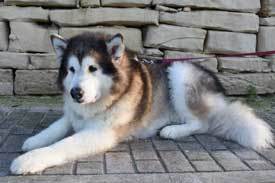
#2. Alaskan Malamute
Alaskan Malamutes are another wolf-like breed that has a striking resemblance to wolves. They are very similar in appearance to Siberian Huskies. It's not uncommon for people to confuse the two.
However, Malamutes are much larger than Huskies. They can weigh about 85 pounds or more when fully grown. When compared to a wolf, Malamutes are smaller and girthier.
Like Huskies, Alaskan Malamutes have a history of pulling sleds. They were typically used to haul heavy cargo, as their larger size and strong muscles made it easy for them to go long distances.
These dogs can be a handful to train. They're very active and quite intelligent. Malamutes are notorious for being escape artists.
A simple fence isn't enough to contain them in many cases, as they can dig underneath or climb onto nearby items to jump over the threshold. The best way to keep an Alaskan Malamute happy is to give them plenty of opportunities to exercise.
When it comes to compatibility, these canines are great for families. They're very loyal to their pack and love to have fun. However, they do have a high prey drive. You may experience trouble if you have other dogs or cats running around.
Related: 12 Things to Know before Getting an Alaskan Malamute
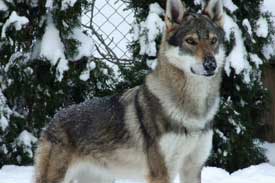
#3. Kugsha
The Kugsha is a relatively new breed that has only recently been domesticated. They're native to the United States. Also known as Amerindian Malamutes, Kugshas are considered to be wolf hybrids.
This is pretty evident just from looking at them. They feature the same color markings and thick winter-ready coat that wolves do. In terms of size, Kugshas are still smaller than wild wolves. They lie somewhere in between Siberian Huskies and Alaskan Malamutes.
Because they're wolf hybrids, they have some unique personality traits. They take on that same independent spirit, which can make them a bit of a challenge when it comes to training. Many owners claim that you can never really own a Kugsha.
Instead, they're part of the family and should be treated as such. If you choose to adopt one, you will more than likely experience some assertive behavior and tests for dominance. However, with proper training, they will become intensely loyal to you and your family.
Kugshas are skilled predators. They love to chase prey and run long distances. These dogs are not for novices. Their predatory nature requires special attention as well, so they're not great for families with small children or other pets.
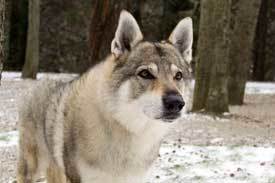
#4. Czechoslovakian Wolfdog
As their name would suggest, Czechoslovakian Wolfdogs are another hybrid breed. These dogs have a well-documented history. They were first developed and bred to work for the Czech military.
Czech scientists went to great lengths to create a dog breed that could aid them in missions. What they came up with was a cross between a German Shepherd and Carpathian wolves.
This unique combination resulted in a highly intelligent dog that has the strength and stamina of a wild canine. During their stint in the military, Czechoslovakian Wolfdogs were trained for tracking and herding jobs.
Like any other wolfdog, teaching one of these pups to behave is essential. However, thanks to their German Shepherd bloodline, they can pick up commands and tasks pretty well compared to other breeds.
The wolfdogs are quite large, weighing around 75 pounds. They have thick coats and those signature triangle-shaped ears. Their coats are somewhat muted, resembling the yellow and gray tones you'll find in wolves.
Developing a good bond with a Czechoslovakian Wolfdog isn't hard. They make very good pets with proper training. They're social animals, so exposure to other people and dogs is a must.
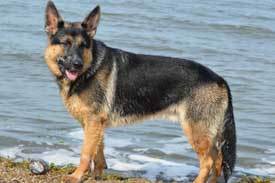
#5. German Shepherd
German Shepherds are one of the most popular breeds in the world. These dogs are known for their intelligence and willingness to learn. You may see German Shepherds performing a wide range of jobs.
They're used by the military, law enforcement, and so much more. When compared to a wolf, German Shepherds have some standout physical features. While they both have perky ears, German Shepherds tend to have larger ones.
In terms of coloring, this breed varies quite a bit. The classic combination of black and brown are the most common. Though, they can also be colored in jet black, white, and gray.
German Shepherds are a great option for families. Despite their large size, they are quite friendly to those that they know.
These dogs are wolf-like canines, so they don't have a lot of the unwanted personality traits that others do. They're relatively easy to train and thrive in social situations.
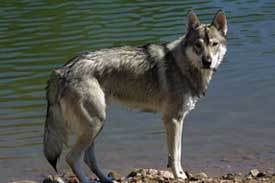
#6. Tamaskan
At first glance, it's easy to mistake a Tamaskan with a wolf. Their slender and athletic bodies, triangular ears, and multi-colored coats are all reminiscent of wild wolves.
There's not a ton of information about Tamaskans out there. They were first created in Finland back in 2006 by cross-breeding malamutes and huskies. Because they're so new, these dogs aren't recognized as an official breed just yet. Though, that may change as they grow in popularity.
Like other dogs on this list, Tamaskans are very athletic and do best with families that like to stay active. They have a lot of energy to get rid of, so you'll need to give them plenty of room to run around and play. These dogs can also get pretty big, weighing up to 90 pounds when they're adults
The great thing about Tamaskans is that they do quite well with children. They can be gentle, loving, and spirited. Of course, it's always important to be extra cautious with dogs of this size. Luckily, Tamaskans aren't that hard to train.
Their intelligence makes it easy for them to figure out right and wrong pretty quickly, so you won't have a hard time getting these pups to adapt to home life.
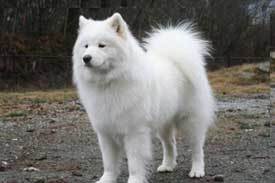
#7. Samoyed
If you're looking for a smaller wolf-like dog, the Samoyed may be for you. Samoyed dogs hail from Siberia and were used for a variety of tasks. They're smart creatures that excel in tracking and hunting tasks.
When it comes to appearance, Samoyed looks like smaller versions of the white wolf. Their soft and fluffy white coats create a mane that frames their faces. Perky triangle ears and black lips create a striking appearance.
Samoyed dogs are probably best known for their signature smile. When they pant, their black lips create a distinct smile outline.
Samoyed dogs make great house pets. They're social animals that get along with pretty much anyone. While these dogs are energetic, they're also not opposed to remaining calm and cuddling up with owners. With some good training, you can get rid of any negative behavioral problems.
This breed is known for causing a ruckus whenever they're unhappy. They won't hesitate to vocalize their feelings. As a result, they don't do well in apartments or close-quarter environments.
One big downside of Samoyed dogs is their susceptibility to health problems. The breed is known to suffer from diabetes, hip dysplasia, and many other health problems. So, you'll need to be proactive about keeping them healthy and active.
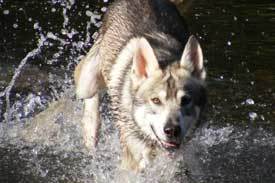
#8. Utonagan
Utonogans were specifically created to take on a wolf-like appearance. They're believed to have been developed in the UK by cross-breeding Siberian Huskies, Alaskan Malamutes, and German Shepherds.
Exact information about the exact source of the breed is a bit fuzzy. Created back in the 1980s, they're not nearly as common as other dogs on this list.
Despite that, Utonogans are beloved creatures among those who have had the opportunity to be around them. Breeders were successful in creating a wolf-like dog.
They're similar in size, have almost identical color patterns, and have that typical wolf-shaped head. What's different about Utonogans is their personality.
They're very friendly and don't have the extreme predatory instincts as wolves. In fact, these dogs are known for being incredibly kind around people and children. They can be trained to perform many different tasks as well, which is a great way to get rid of their high energy levels.
Like many other dogs on this list, they can be a bit destructive if they're bored, so make sure to keep them active.
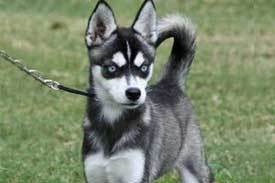
#9. Alaska Klee Kai
The Alaskan Klee Kai is an adorable little dog that's often mistaken for the Pomsky. However, these dogs were created through miniaturization. Many bloodlines were combined to create a small dog without dwarfism.
When fully grown, they weigh 22 pounds at most.
Like Huskies, these dogs come in a range of colors. Typically, they take on a multi-colored coat and have signature markings on their face like a wolf.
They also have the large erect ears and the wolf-like head shape, albeit, much smaller.
Alaskan Klee Kais do very well with families. Their playful attitudes and high energy levels make them great around kids. These dogs are also fiercely loyal. In fact, they don't do well around strangers.
They'll often exhibit reserved behavior when a new face comes around. To let you know about their discomfort, they may even start to whine or howl.
With that being said, you can stave this behavior off with some training and regular socialization. Alaskan Klee Kais are very adaptable, making them great for owners that don't have a ton of experience with wolf-like dogs.
Conclusion
While you may not be able to live with a full-blown wolf, these dog breeds are excellent alternatives. They all take on that majestic wolf appearance without the risks.
Generally, wolf-like dogs and hybrid breeds require a bit more training than your average Lab or Poodle. Before you adopt one of these pups, do your research and study up on proper training techniques to set your new furry friend up for life of success.
Also Read:

